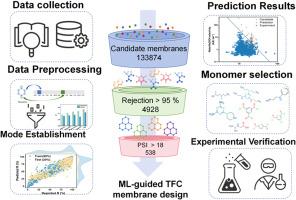基于片段的机器学习加速水净化用薄膜复合聚酰胺膜的逆向设计
IF 9
1区 工程技术
Q1 ENGINEERING, CHEMICAL
引用次数: 0
摘要
薄膜复合聚酰胺(TFC PA)膜以其优异的液体分离能力而闻名。通过化学结构和性能之间的关系来开发新型单体将有助于加速TFC膜的发展。本文采用机器学习(ML)来指导TFC PA膜的合理设计。一个综合了单体片段、合成和操作条件、膜和溶质性质的综合数据集用于训练ML模型。基于碎片的Catboost模型对渗透和溶质截留都具有强大的预测能力。特征贡献分析表明,单体的片段,如胺和亚甲基,以及孔径和阴离子半径,是性能的重要决定因素。利用训练有素的多目标筛选模型,从133864个候选膜池中有效地鉴定出表现最佳的膜。实验验证证实,两种ml鉴定的TFC PA膜在保持高Na2SO4排斥的同时表现出增强的通透性。这项工作提出了一种新颖的方法,改变了TFC膜逆设计的范式,并可以扩展到其他材料系统,以加速材料的发现。本文章由计算机程序翻译,如有差异,请以英文原文为准。

Accelerating inverse design of thin-film composite polyamide membranes for water purification via fragment-based machine learning
Thin-film composite polyamide (TFC PA) membranes are renowned for their excellent liquid separation capabilities. Developing novel monomers through the relationship between the chemical structures and performance will help accelerate the development of TFC membranes. Here, machine learning (ML) is employed to guide the rational design of TFC PA membranes. A comprehensive dataset integrating monomer fragments, synthetic and operation conditions, and properties of both membranes and solutes was used to train ML models. Fragment-based Catboost models exhibit robust predictive capability for both permeance and solute rejection. The feature contribution analysis revealed that the frgament of monomers such as amine and methylene groups, as well as pore size and anion radius, are paramount determinants for performance. Leveraging the well-trained model for multi-objective screening, top-performing membranes are efficiently identified from a pool of 133864 candidates. Experimental validation confirmed that two ML-identified TFC PA membranes exhibited enhanced permeance while sustaining high Na2SO4 rejection. This work presents a novel approach that shifts the paradigm in the inverse design of TFC membranes and can be extended to other material systems for accelerated materials discovery.
求助全文
通过发布文献求助,成功后即可免费获取论文全文。
去求助
来源期刊

Journal of Membrane Science
工程技术-高分子科学
CiteScore
17.10
自引率
17.90%
发文量
1031
审稿时长
2.5 months
期刊介绍:
The Journal of Membrane Science is a publication that focuses on membrane systems and is aimed at academic and industrial chemists, chemical engineers, materials scientists, and membranologists. It publishes original research and reviews on various aspects of membrane transport, membrane formation/structure, fouling, module/process design, and processes/applications. The journal primarily focuses on the structure, function, and performance of non-biological membranes but also includes papers that relate to biological membranes. The Journal of Membrane Science publishes Full Text Papers, State-of-the-Art Reviews, Letters to the Editor, and Perspectives.
 求助内容:
求助内容: 应助结果提醒方式:
应助结果提醒方式:


